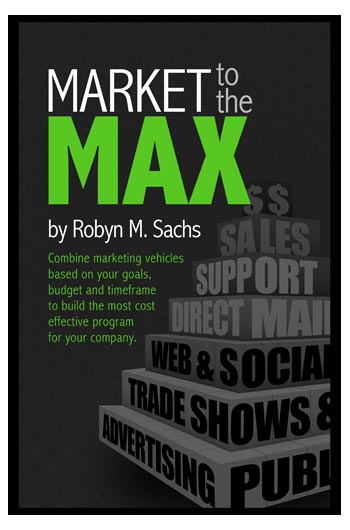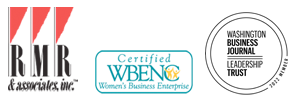
Combine marketing vehicles based on your goals, budget and timeframe to build the most cost effective program for your company.
There’s a reason why the Great Pyramids have stood for so long: They are built to last. A solid base provides a secure foundation for the subsequent layers. Each new layer is built upon the previous layer until the entire structure is so solid it can withstand ages of wear and tear and still remain standing. In a similar fashion, this marketing expert has found a way to build a marketing plan/program that will stand the test of time.
It will work for you in good times and bad, in upturns and downturns. Through it all, the “Marketing Pyramid” is built to last.
Meet the Author
Robyn Sachs
 Robyn M. Sachs has served as president and CEO of RMR & Associates, Inc. since purchasing the company in 1987. Over the years, RMR has earned a reputation for aggressive campaigns that produce measurable results. In 2000, RMR was named the 10th fastest growing PR agency in the United States and the fastest growing PR agency in Maryland by PRWEEK. RMR has also been awarded the “MC Icon Award” for best branding campaign in the country for their work with PSINet and an “ADDY Award” for the best commercial website by the Ad Club of Washington, DC.
Robyn M. Sachs has served as president and CEO of RMR & Associates, Inc. since purchasing the company in 1987. Over the years, RMR has earned a reputation for aggressive campaigns that produce measurable results. In 2000, RMR was named the 10th fastest growing PR agency in the United States and the fastest growing PR agency in Maryland by PRWEEK. RMR has also been awarded the “MC Icon Award” for best branding campaign in the country for their work with PSINet and an “ADDY Award” for the best commercial website by the Ad Club of Washington, DC.
In 1998, Robyn was awarded the Ernst & Young “Entrepreneur of the Year Award.” Additionally, the Washington Business Journal has recognized the agency as one of the Top 25 Advertising Agencies and Top 25 Public Relations Firms annually since 1991 and included RMR in its listing of Washington’s Largest Women-Owned Businesses since 1990.

Adding Value to Your Company with Marketing
Marketing 101: A Necessity, not a Luxury
What kind of honor is it to be recognized as “Small Business’ Best-Kept Secret”? No matter how long you’ve been in business, customers are less likely to buy from you if they have never heard of your name or product. Name recognition and visibility are the keys to growing your business, and marketing communications is the way to make your company more visible.
Each big business began as a small company with a plan – not just a business plan, but an integrated marketing plan, one that would introduce its products, services, leaders and mission into the marketplace using a series of tried-and-true vehicles. In 1987, when I purchased and became president of RMR Advertising, then a struggling advertising agency, I knew the only way to climb to the top of our industry was to do for our own company what we do for our clients: solidify our internal messaging and position, create an awareness campaign, share RMR’s message and mission to everyone who would listen, and do so as frequently as possible. RMR Advertising is now RMR & Associates, an integrated advertising, marketing, and public relations agency that caters to fast growing companies and organizations. When I first purchased the company we were only a four-person agency. With a structured plan, a consistent communications effort, and a lot of enthusiasm, we have grown by 600 %, and have been recognized as one of the country’s fastest-growing Integrated Marketing Firms.
When people hear the word “marketing,” they automatically think of advertising, public relations, social media or direct mail. But these are merely the vehicles or tactics we use to drive the marketing message home. Marketing is a strategy spelled out in a written plan – a plan that you commit to and invest in consistently for at least one year.
Use the power of Integrated Marketing.
A good marketing plan will integrate the right marketing tools to accomplish your goals. Rarely is one marketing vehicle alone the right way to go. After analyzing the current status of your business and your goals for the year, your marketing firm should design a marketing plan that integrates several marketing tools. Perhaps you’ll start with direct mail to generate leads that can be followed up with sales calls to close the deal. During tradeshow season, you may advertise in trade journals and websites to announce your participation, as well as update your own website to announce it as well. And when you nab that big client and gain the envy of all your competitors, you’ll surely want to get the word out in a press release, which will hopefully generate interest for a feature article on your business’ secrets to success.
Integrated Marketing can cut the cost of selling.
By using the right marketing tools, integrated marketing can qualify sales leads, thus cutting the ultimate cost of selling. The Marketing Pyramid illustrates the Cost Per Lead of various marketing vehicles.
The sales call is the most expensive method of marketing. That’s because it is a personal, one to one approach, which, while valuable in promoting customer relationships, should not be wasted on the process of securing qualified leads. Public relations, social media and advertising have the ability to cast the widest nets; therefore their cost per lead is the lowest. Once these and other marketing vehicles have generated qualified leads, the more expensive sales call can be used only on those who are truly potential customers.
Like any investment, marketing pays off over time. After a year, you will start to see a positive correlation between your commitment and your investment. Remember “The Rule of Seven” when developing a marketing strategy: It takes 7 consistent impressions over 12 months for consumers to recognize your message. Frequency over time is the equation that multiplies marketing results.
A great example is one of our clients, Windsor Construction Group. When the economy took a turn for the worse and companies were looking for ways to cut costs, one of the first things they often cut is marketing. But Windsor knew that marketing was the key to prospering in tough times. They targeted a direct mail campaign to the exact neighborhoods they wanted to reach, and advertised in those neighborhood newsletters and websites. They continued their public relations efforts to increase image and awareness, revamped their website, and used their trucks as signage.
The result? Just one year into their marketing plan, Windsor is having their best year ever. Marketing can and does make the difference – even in a down market.
Be sure your yearlong marketing plan covers these key points:
- Market segment of interest. Define your market. What portion of the consumer or business market do you serve best? What is your niche?
- Market segment size and population. Who are your potential buyers? If they are consumers, define their age, sex, income, geography, ethnicity, etc. If they are businesses or industries, identify their company size, geography, share of market, reputation, etc.
- Competitors’ strengths and weaknesses. Prioritize your main competitors. Research their strengths and weaknesses through their websites, newsgroup postings, social networks and industry publications. Utilize mystery shoppers, talk to former employees, or conduct focus groups with their customers.
Don’t spread yourself too thin. Identify your best target audience and get your name in front of them a minimum of 6-7 times over a year. Successful marketing programs combine a variety of media – PR, advertising and direct mail for example – all targeted to the same audience. This approach will achieve far better recognition and response than the shotgun approach of placing 1 ad here and 1 ad there.
- Product differentiation, positioning, promotion, pricing, support, and service. Your marketing communications agency can help you establish many of these aspects that will become your key selling points or USP’s (Unique Selling Propositions).
- Costs and budget. Remember, properly done, your marketing plan is an investment that will pay off far more than its expense. It’s better to have a lean 10 to 20 page-marketing plan that is used and updated every three months, than a 200-page document gathering dust on a shelf.
- The FUD factor. That’s marketing talk for Fear, Uncertainty, and Doubt. The less well known you are by your potential market, the higher the FUD factor. Increase awareness of your company through your marketing strategy, and you lower the FUD factor.
- Where you are today, and where do you want to be? Quantify your current market share and reputation, and then articulate what you want them to be in the near future.
- How can you get there? Advertising? PR? Direct mail? Social Media? Or a combination of these plus Internet, tradeshows, and telemarketing?
- What will it cost? Never run just one ad to “test the waters.” Remember the Rule of Seven. Your budget should be large enough to allow for frequency (at least seven impressions) over one year.
- How will you measure success? A good marketing communications plan will include ways to measure results. You can measure image, awareness, number of qualified sales leads, article placements, mentions, benchmark studies, sales stats, etc.
By using these tools and keeping yourself informed about the markets you are in, as well as the markets you would like to enter, you will build image and awareness, generate qualified sales leads, and ensure that you are positioned to take advantage of opportunities. In short, you will add value to your company – value that you can see, measure, and build upon.

BUY THE BOOK
128 pages
ISBN 978-0-615-4095101
Paperback; $24.95
Printed in the USA
